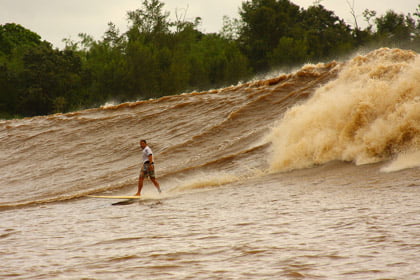
Every year, around the spring equinox (between March and April), the surfers of the world gather at São Domingos do Capim, a Brazilian Municipality. Since 1999, this town has been hosting the annual sport’s championship on the adjacents of the Guama’River. But aren’t tides an occurrence in the oceans and seas?

A Short Geography Lesson
The Guama’River is one of the three rivers that flow into the mouth of the Amazon River. We are all familiar with the concept of how the moon’s gravitational force causes the water of the sea to fall and rise, a phenomenon known as the tide.
Twice every year, the forces of the universe create a miracle- an equinox, when the sun, the moon, and the earth are all on the same line. The sun, as well as the moon, pulls at the earth’s waters creating tides like no other day. The pull is so strong that the water from the vast Atlantic Ocean rushes into the Amazon in the direction of a river, forming what is called a tidal bore.

Some Crazy Facts
Okay, let’s stop with the academic lingo! What is so fascinating about ocean water flowing into a river?
The average waves on the beaches are around 1.5 meters tall and last for a very short period of time. In the Amazon, during the equinoxes, these tidal bores are so large and long- 4 meters/ 12 feet high and last for more than 30 minutes.
These waves crash with the speed of 15 to 24 kilometers per hour and go on for hundreds of miles. It can be heard thirty minutes before arrival. In 2003, a record was created by Brazilian Picuruta Salazar who rode for about 12.5 km for 37 minutes.

Danger- Tide
Though the pororoca seems like the surfer’s paradise, it is not only the largest but also the most dangerous tidal bore across the globe.
The name ‘pororoca’ itself has multiple perilous connotations to it:
- In the indigenous Tupi language of the region, the word pororoca could translate into ‘great roar’.
- According to the Portuguese version, poroc-poroc was an indigenous way of expressing complete destruction.
- It is also speculated that is a combination of the words: poroc– to take out and oca– house.
The wave is extremely dangerous as it carries the debris from the dense rainforests of the region due to its extreme force.
Dangerous fauna like jaguars, piranhas and snakes lurk in the waters or might be encountered during the course of surfing. The pororoca could be a never-ending wave, or literally the end!
Read Also: This Earthquake Is Not Natural But Created By People Like You And me.



